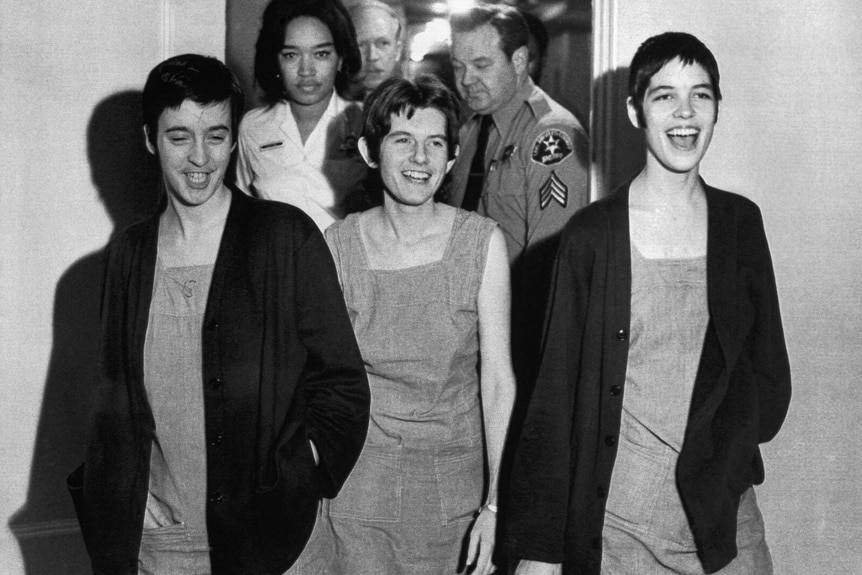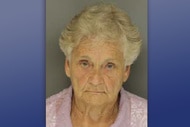Create a free profile to get unlimited access to exclusive videos, breaking news, sweepstakes, and more!
How Did the Manson Family Retain and Control Members? "A Spiritual Awakening"
Career criminal Charles Manson may have lured his followers in with love and acceptance, but he'd later turn to violence to control those in his midst.
The Manson Family, as it’s often called, was once touted as the embodiment of free love, attracting young men and women looking to break away from traditional society in the late 1960s. But as time went on within Charles Manson’s cult, his followers found themselves falling deeper under the control of their charismatic leader — leading some to even kill for him.
In August of 1969, Manson’s followers broke into the home of pregnant actress Sharon Tate and mercilessly slaughtered her and four others. They targeted Los Angeles grocer Leno LaBianca and his wife Rosemary the following night, carving the word “war” into Leno’s stomach during the frenzied attack.
In the hectic aftermath, those responsible for the killings were put on trial, while Manson’s other followers remained completely devoted to him, carving an “x” into their forehead, shaving their head, or even crawling on their hands and knees to the courthouse each day to show their complete and absolute devotion to him.
More than 50 years later, many are still mystified about how Manson was able to draw his followers in and get them under his control. Making Manson, Peacock’s three-part docuseries streaming now, includes interviews with Manson’s one-time followers and provides new insight into how seemingly normal young adults could be transformed into cold-blooded killers.
“Charlie was very good at not conning, but influencing people without them knowing it,” his former prison cellmate Phil Kaufman explained in the docuseries. “These kids had run away from home and they were susceptible. The hook was in …and he just really knew how to take advantage of them.”
How did Charles Manson recruit members?
Manson was fresh off a stint in federal prison when he was released in 1967 and found himself immersed in the middle of the hippie counterculture movement.
While behind bars, Manson used his time to listen to “all the dying crooks” and his fellow prisoners, learning all he could about how to manipulate and influence others.
“My teacher, Pete the pimp, he taught me how to hustle, and how to pimp and whore, and to do all those things. I took advantage of everything. I’m telling you straight up, man,” Manson said himself from prison in a series of recorded conversations with friend John Michael Jones, played in Making Manson.
The chameleon-like cult leader used those skills after his release from prison to find young women fed up with society’s traditional roles and often alienated them from their families.
“I think that Manson’s real gift, if you would call it that, was that he chose his followers very young,” journalist Linda Deutsch said in the docuseries before her death earlier this year. “They all had had disputes with their parents, they were part of a counterculture era, which made them in conflict with most adults.They saw themselves as knowing everything, but they knew nothing.”
To draw his followers in, Manson showered them with love and acceptance.
Former Manson follower Dianne “Snake” Lake was just 14 years old when she joined Manson.
“When I met Charlie and the girls, they were all sitting around in a circle and Charlie got up and invited me to come sit in the circle. They all instantly love bombed me. It was so emotionally fulfilling to feel so loved and accepted,” she recalled. “I mean I needed, like, a father figure or somebody to make me feel like I belonged, and he was able to do it and that’s what I needed. I think he was somebody a little bit different for all of the girls and yet he had this way of making us all feel like we were the special one.”
Nikki Meredith, author of The Manson Women and Me: Monsters, Morality and Murder, said in Oxygen’s 2019 special Manson: The Women, that Manson specifically targeted women who were “hungry for a connection” and quickly identified each person’s most significant vulnerabilities.
“He had the ability to pay attention, which picked up strengths, but most important, vulnerabilities, and he knew how to manipulate that,” she said.
For Catherine “Gypsy” Share, Manson and other cult members served as a “family” after she lost her parents.
“He could really perceive what someone had in them. He just said, ‘You’re not like all the rest, you’ve gone through a lot of hard knocks, haven’t you?’” she remembered in Making Manson, adding that people just “felt comfortable with him.”
Manson also worked to develop an intimate connection with his female followers that began shortly after meeting them. Lake remembered having sex with Manson the same night she met him.
“Later Charlie took me to the bus and made love to me like I was a woman, not just a little child, which made me feel wonderful,” she said.
Despite their significant age difference and her status as a minor, Lake said Manson treated their sexual interactions like they were “an opportunity for me to get rid of my inhibitions.” It wasn’t until years later that she realized Manson had been taking advantage of her.
“I wasn’t street smart. I just wasn’t,” she said.
Manson also found a way to influence those in the group and convey his own thoughts and ideas through his music.
“We’d get in a circle and Charlie would play his guitar. He wanted to share his message,” Lake said. “I think that that was important for him, he wanted people to listen to his songs.”
Did the Manson Family do drugs?
But there was also another way that he began to subtly gain control of his followers. Manson often plied his followers with drugs like LSD, making those in the group more susceptible to his way of thinking.
“We would take LSD and we sat around and got high. An acid trip in the Manson Family was more of a spiritual awakening and Charlie did give it to us like a sacrament,” Lake said. “He would put the tab on each person’s tongue.”
In one drug-laden trip, Manson told his followers that he believed he was being crucified like Jesus Christ, introducing the idea that he was a savior-like figure himself. Yet, for the most part, Manson abstained from using drugs himself.
“Manson was very manipulative and he knew the impact of drugs, so he very carefully avoided taking them himself and then handed out those drugs to the girls and never, never got himself stoned in front of them, because he wanted to be in control,” journalist and author Ivor Davis explained in Making Manson.
It was a strategy that Manson seemingly confirmed himself from behind bars.
“I never really lose my head on something, you know,” he told Jones in the recordings. “I never lose control. But I take control.”
How did the Manson Family turn violent?
As Manson’s influence over the group began to grow, those in the cult said he began to abuse his power, often using violence to keep his followers under his control.
“He definitely used us and he definitely abused us,” Lake said. “You know, I got hit and beat and … raped once and I think the other girls probably did too, but they kept it a secret.”
Share described being beaten “within an inch of my life” after Manson discovered she’d rolled a barrel down a hill that broke open and spilled.
“If you can scare somebody … you’ve got a lot of power,” Manson’s associate and music producer Gregg Jakobson explained. “It’s fear, you know, it goes a long way.”
Manson capitalized on that fear by preaching to his followers that the world was on the verge of a violent race war, something that didn’t seem all that far-fetched given the race riots breaking out all across the country at the time.
“Charlie was my safety,” Share recalled of the turbulent time. “I thought that he knew how to survive, he knew what was going to happen and if I stayed close to him I would survive also.”
According to Lake, things within the group began to get more “dark” and “frenetic” by the summer of 1969.
Manson got his followers to push their boundaries by recruiting them to go on missions known as “creepy crawlies,” where they’d break into homes and rearrange the furniture.
“So from that point of view, he was able to manipulate them to do these pre-operations,” Davis said of the training.
Then in late July 1969, Bobby Beausoliel and several other members of The Family went to the home of Manson friend and music teacher Gary Hinman. Hinman had allegedly sold Beausoliel a bad batch of drugs and they wanted their money back. When Hinman didn’t have any money to give them, Manson came to the home and slashed Hinman in the face with a sword. When Hinman threatened to go to the police over the wound, Beausoliel killed him. He was arrested for the murder on Aug. 6, 1969.
A few nights later, some of Manson’s followers went on their savage murder spree in what some believe was a misguided attempt to try to free Beausoliel by making the murders look like “copycat” crimes to Hinman’s murder.
“It was a slippery slope where we would do anything for each other,” Share said.“We were loyal to each other. We were one for all for one and, you know, [Manson] was the one.”
What happened to Manson’s followers after his arrest?
Manson, Watson, Patricia Krenwinkel, Susan Atkins, and Leslie Van Houten were later arrested and charged with the murders — but even that didn’t sway his devoted followers.
Instead, the Manson Family camped out outside the courthouse, shaved their heads, and carved Xs into their foreheads after Manson showed up in court one day with the same marking on his forehead. He said at the time that it was meant to symbolize that he’d been “x-ed out of society.”
Share, who was among those outside the courthouse, often praised Manson in television interviews.
“A lot of my shame comes from getting on the screen and being so out of touch with my heart and my soul,” she said now. “ I definitely loved Charlie with everything that I had.”
Share admitted she was beginning to have some doubts about Manson, but even from behind bars, the threats of violence didn’t end. She remembered that during one jailhouse visit with Manson, he told another male follower that if she tried to leave the group he should tie her to a car and drag her to the ranch.
“So even though this was nagging at me, I smiled at the cameras, I sat on the corner, professed my love for him, because I couldn’t walk away,” she said.
In one dramatic display, the group members even crawled on their hands and knees down Southwest Boulevard to the courthouse to show support for Manson. The move backfired, however, when it ended up helping the prosecution.
“With his family members crawling on their knees, he played right into our hands because we had to show how much control he had over these people,” prosecutor Stephen Kay remembered. “He was like exhibit A in our trial. We couldn’t have asked for more.”
Manson, Krenwinkel, Van Houten, and Atkins were all found guilty of murder. Watson was convicted in a separate trial.
Manson spent the last decades of his life behind bars. While many of his followers denounced him, a select few remained loyal to him until his death in 2017.
Learn more about Charles Manson's crimes in Making Manson, streaming exclusively on Peacock.
































